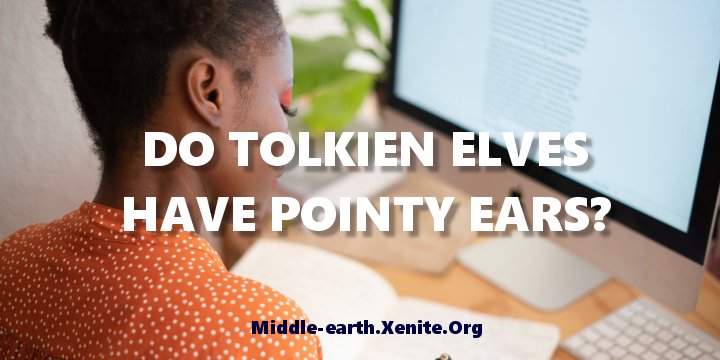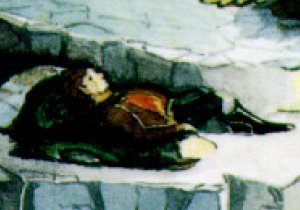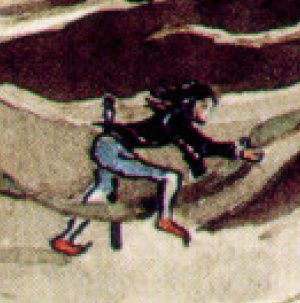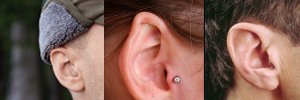
Q: Do Tolkien’s Elves Have Pointy Ears? No
ANSWER: No. Tolkien’s elves do not have pointy ears. However, we tolerate these endless debates about whether Tolkien’s elves had pointy ears because … well, I don’t know why any more. The argument for pointy ears can be summed up as “we’re going to ignore the stories and rely on obscure, abandoned or rejected texts that don’t explicitly say Tolkien’s elves had pointed ears”.
The facts of Tolkien’s elf ears are:
- At no time during his life did J.R.R. Tolkien publish anything that said elves had pointed ears
- Arguments for pointed ears on Tolkien elves take a handful of texts out of context (the “elvish” comment in letter 27 was to describe Bilbo’s ears for an illustrator who had never read the book – hence, it doesn’t reference any Tolkien elves)
- Tolkien’s fiction distinguished between elves and men by their voices and eyes
- Tolkien did write that the children of elves and men were easily mistaken for each other – which confusion pointy ears should have prevented
- Tolkien’s own private notes largely discount the idea
- Fannish projections of pointed elvish ears appeared long before Tolkien’s linguistic notes were published
- There is no “precedent” in Tolkien’s writings for pointy ears
- Invoking the Uzi rule (“he didn’t specifically say they don’t have pointy ears so they must have”) doesn’t put pointy ears on Tolkien’s elves
- The fact tiny little garden elves were depicted with pointy ears prior to Tolkien’s fiction has nothing to do with Tolkien’s fiction
Despite the fact that from the time he published The Hobbit in 1937 to his death in 1973 J.R.R. Tolkien never said to anyone or wrote in any book he published or intended to publish that his Elves had pointed ears, some people insist they must have.
In simpler terms: To date, no stories written by J.R.R. Tolkien have been published in which his Elves are described as having pointed ears.
There are no references to Elvish ears in any published Tolkien story. In fact, one must ignore the stories published in order to fabricate seemingly convincing arguments for pointy-eared Tolkien Elves.
How Pointy-eared Elf Advocates Twist Tolkien’s Words to Fabricate Pointy-eared Elves
When fans ask if Tolkien’s elves have pointed ears, people usually refer to two controversial texts that were never integrated into any of J.R.R. Tolkien’s stories. The first text is taken from Letter No. 27, which Tolkien wrote in March or April 1938 in response to the Houghton Mifflin Company, who had asked for drawings to be used in the American edition of The Hobbit.
I am afraid, if you will need drawings of hobbits in various attitudes, I must leave it in the hands of someone who can draw. My own pictures are an unsafe guide – e.g. the picture of Mr. Baggins in Chapter VI and XII. The very ill-drawn one in Chapter XIX is a better guide than these in general impressions.
I picture a fairly human figure, not a kind of ‘fairy’ rabbit as some of my British reviewers seem to fancy: fattish in the stomach, shortish in the leg. A round, jovial face; ears only slightly pointed and ‘elvish’; hair short and curling (brown). The feet from the ankles down, covered with brown hairy fur. Clothing: green velvet breeches; red or yellow waistcoat; brown or green jacket; gold (or brass) buttons; a dark green hood and cloak (belonging to a dwarf).
Actual size – only important if other objects are in picture – say about three feet or three feet six inches. The hobbit in the picture of the gold-hoard, Chapter XII, is of course (apart from being fat in the wrong places) enormously too large. But (as my children, at any rate, understand) he is really in a separate picture or ‘plane’ – being invisible to the dragon.

There can be no doubt that Tolkien pictured his Hobbits as having pointed ears. The best representation Tolkien himself drew of Bilbo is in the picture “The Eagle’s Eyrie”, where Bilbo is waking up. We can clearly see Bilbo’s elongated ear. Allowing for Tolkien’s own self-deprecation, we can argue that the elongation might be unintentionally exaggerated or perhaps intentionally so for emphasis.
As there is no controversy regarding the shape of Hobbit ears, people quickly fall to debating whether the Hobbit ears are an acceptable reference for the shape of Elvish ears (based on the letter cited above). There are two problems with using the letter to argue that Tolkien’s elves have pointed ears. First of all, no Tolkien biographer or researcher has established that anyone at Houghton Mifflin Company had ever seen a Tolkien picture or story depicting Elves with pointed ears (hence, the letter does not in any way use Tolkien’s elves as a reference). Secondly, the adjective “elvish” is attested in widespread use going back at least to Shakespeare’s time. The Etymology Online Dictionary says the word goes back to the 14th century (1300s England), well before Shakespeare. Hence, we can neither show that the Houghton Mifflin employees would have had any knowledge of Tolkien’s Elves (other than what is given in the text of The Hobbit) nor that Tolkien himself was using “Elvish” in any way to reference details from his own stories.

Now, we don’t have to leave the discussion with The Hobbit. There is another famous painting Tolkien made called “Beleg Finds Gwindor in Taur-nu-Fuin” in which the Sindarin/Noldolin Elf Beleg finds Gwindor of Nargothrond sleeping in the woods. Technically, the second elf (not pictured here) is Flinding and Beleg is a “Noldo”. Christopher Tolkien suggests the painting was made in 1927 or 1928 (Cf. The Book of Lost Tales, Part II, “Turambar and the Foalokë”). It’s very difficult to examine the figures in sufficient detail to see their faces, much less their ears. Flinding/Gwindor’s face is hidden but as you can see here Beleg’s face is bearded. So this painting does not help resolve the question, do Tolkien’s Elves have pointed ears?
As an aside: Aren’t Tolkien’s fans convinced that his elves are beardless? Still, we cannot see enough of Beleg’s ear to know if it is pointed or not. So, lacking any evidence of a pointy-eared elf in this painting, we have to overcome the fact that Beleg has a beard in order to rationalize or justify using this image to argue that Tolkien’s elves have pointed ears. (In fact, the whole bearded elf debate was thrown for a loop by Vinyar Tengwar but that is another story.) Still, some people remain convinced that Tolkien’s elves have pointed ears. Why?
There is an obscure text (usually referred to as Words, Phrases and Passages) published by the Elvish Linguistic Society in which the following is found and oft-cited:
Q lasse ‘leaf’ (S las); pl. lassi (S lais). It is only applied to certain kinds of leaves, especially those of trees, and would not e.g. be used of leaf of a hyacinth (linque). It is thus possibly related to LAS ‘listen’, and S-LAS stem of Elvish words for ‘ear’; Q hlas, dual hlaru. Sindarin dual lhaw, singular lhewig.
Note the absolute LACK of any mention of pointed ears – but this article has been criticized on the Web for years for omitting any mention of that passage. Okay, there you go. Yet another piece of evidence NOT mentioning pointy elf ears has now been added to this article.
The last piece of evidence that people use to argue for Tolkien’s elves having pointed ears is an entry from “The Etymologies”, a pre-Lord of the Rings glossary of Elven words that Christopher Tolkien published in The Lost Road and Other Writings.
Las (1)
*lasse ‘leaf’: Q lasse, N lhass; Q lasselanta ‘leaf-fall, autumn’, N lhasbelin (*lassekwelene), cf. Q Narquelion [ KWEL ]. Lhasgalen ‘Greenleaf’ (Gnome name of Laurelin). (Some think this is related to the next and *lasse ‘ear’. The Quendian ears were more pointed and leaf-shaped than [human].)Las (2)
‘listen’. N lhaw ‘ears’ (of one person), old dual *lasu – whence singular lhewig. Q lar, lasta- ‘listen’; lasta ‘listening, hearing’ – Lastalaika ‘sharp-ears’, a name, cf. N Lhathleg. N lhathron ‘hearer, listener, eavesdropper’ ( *la(n)sro-ndo ) ; lhathro or lhathrando ‘listen in, eavesdrop’.
Well, this seems pretty convincing, doesn’t it? The expression “more pointed and leaf-shaped than […]” clearly implies some measure of pointiness. However, Christopher was not sure that his father had written “human” at the end of the sentence. It’s hard to imagine what else could go there (and this article has been criticized for not mentioning the fact that at least one other person looking at the text has declared that it absolutely must be “human”) but there is no need to quibble over Christopher’s guess. Human ears can indeed seem very pointed. Tolkien surely had opportunity to notice as much.

Examples of How Tolkien Actually Compared Elves to Men
But there’s still one problem: Not one of Tolkien’s stories mentions Elvish ears. So if you’re looking for proof that Tolkien elves have pointed ears, you won’t find any. In fact, in every passage where characters or the narratives single out any particularly “Elvish” features about Elves in Tolkien’s stories, the references are to either the Elves’ faces or their eyes. As an example, in “Narn i Chin Hurin” (Unfinished Tales of Numenor and Middle-earth) we read the following:
In this way Sador would speak to Túrin as he grew older; and Túrin began to ask many questions that Sador found hard to answer, thinking that others nearer akin should have had the teaching. And one day Túrin said to him: “Was Lalaith indeed like an Elf-child, as my father said? And what did he mean, when he said that she was briefer?”
“Very like,” said Sador; “for in their first youth the children of Men and Elves seem close akin. But the children of Men grow more swiftly, and their youth passes soon; such is our fate.”
Still not sure if Tolkien’s elves do or do not have pointed ears? In the essay “Laws and Customs Among the Eldar”, published in Morgoth’s Ring, Tolkien wrote:
The Eldar grew in bodily form slower than Men, but in mind more swiftly. They learned to speak before they were one year old; and in the same time they learned to walk and to dance, for their wills came soon to the mastery of their bodies. Nonetheless there was less difference between the two Kindreds, Elves and Men, in early youth; and a man who watched elf-children at play might well have believed that they were the children of Men, of some fair and happy people. For in their early days elf-children delighted still in the world about them, and the fire of their spirit had not consumed them, and the burden of memory was still light upon them.
This same watcher might indeed have wondered at the small limbs and stature of these children, judging their age by their skill in words and grace in motion. For at the end of the third year mortal children began to outstrip the Elves, hastening on to a full stature while the Elves lingered in the first spring of childhood. Children of Men might reach their full height while Eldar of the same age were still in the body like to mortals of no more than seven years. Not until the fiftieth year did the Eldar attain the stature and shape in which their lives would afterwards endure, and for some hundred years would pass before they were full-grown.
Now, if you have made it this far, you are probably in doubt, or perhaps convinced one way or another, or waiting for the next point in an endless litany of tit-for-tat. You don’t have to accept that Tolkien elves do not have pointed ears. But we can also point to Tuor and Aragorn looking like Elven lords in the stories, and Prince Imrahil, and people will still point to that entry in “The Etymologies”, a work to which Tolkien returned less and less often in the years after he published The Hobbit.
J.R.R. Tolkien’s Conclusion: No Pointy-eared Elves
To be honest, if you’re still asking or arguing that Tolkien’s Elves’ had pointy ears, you have probably missed the real point of all this. J.R.R. Tolkien came to the conclusion that HIS Elves never had pointed ears.
If we assume for the sake of discussion that J.R.R. Tolkien could not make up his mind, there is no way anyone else can establish the canonical facts on the matter. So the next time you see someone ask if Tolkien’s Elves have pointy ears, just smile knowingly. You’re glimpsing the beginning of the journey. Perhaps it will lead here; perhaps somewhere else.
But what about the Tolkien Society FAQ Page? The Tolkien Society’s official FAQ page says, on the basis of the faulty arguments disproved above, that Tolkien’s elves have pointed ears. That just means the Tolkien Society is wrong.
See Also
How Much are Peter Jackson’s Elves Like Tolkien’s Elves?
Are All Tolkien Elves Fair-skinned?
How Reliable are The Etymologies as a Tolkien Source?
Much Ado about Arwen, Elven Princess
# # #
Have you read our other Tolkien and Middle-earth Questions and Answers articles?

 This article is featured in the Middle-earth Blog Hot Zone.
This article is featured in the Middle-earth Blog Hot Zone.